List of Frankish kings
The Franks were originally led by dukes (military leaders) and reguli (petty kings). The Salian Merovingians rose to dominance among the Franks and conquered most of Roman Gaul. They also conquered the Gaulish territory of the Visigothic Kingdom in 507. The sons of Clovis conquered the Burgundians and Alamanni. They acquired Provence and made the Bavarii and Thuringii their clients. The Merovingians were later replaced by a new dynasty called the Carolingians in the 8th century. By the end of the 9th century, the Carolingians themselves were replaced throughout much of their realm by other dynasties.
A timeline of Frankish rulers is difficult since the realm was, according to old Germanic practice, frequently divided among the sons of a leader upon his death and then eventually reunited through marriage, treaty, or conquest. Thus, there were often multiple Frankish kings ruling different territories, and divisions of those territories was inconsistent over time. As inheritance traditions changed, the divisions of Francia (a modern historiographical term used to denote the lands of the Franks) became more-or-less permanent kingdoms; West Francia formed the nucleus of what later became the Kingdom of France, East Francia evolved into the Kingdom of Germany, and Middle Francia become the Kingdom of Lotharingia in the north, the Kingdom of Italy in the south, and the Kingdom of Provence in the west. West and East Francia soon divided up the area of Middle Francia, and Germany passed from Carolingian control in 911 with the election of Conrad I as king.
The idea of a "King of the Franks" or Rex Francorum gradually disappeared over the 11th and 12th centuries. The title "King of the Franks" continued to be used in the Kingdom of France until 1190. While the Kingdom of the Franks had long been extinct by this time, the title "Queen consort of the Franks" continued to be used until 1227. This represented a shift in thinking about the monarchy from that of a popular monarchy (the leader of a people, sometimes without a defined territory to rule) to that of a monarchy tied to a specific territory.
King of the Franks (509–511)
Merovingian dynasty
Clovis I united all the Frankish petty kingdoms as well as most of Roman Gaul under his rule, conquering the Domain of Soissons of the Roman general Syagrius as well as the Visigothic Kingdom of Toulouse. He took his seat at Paris, which along with Soissons, Reims, Metz, and Orléans became the chief residences. Upon his death, the kingdom was split among his four sons.[1]
| Name Reign |
Portrait | Birth | Marriage(s) Issue |
Death | Claim |
|---|---|---|---|---|---|
| Clovis I 509 – 27 November 511 |
.jpg) |
c. 466 Tournai Son of Childeric I and Basina of Thuringia |
(1) Unknown concubine 1 son (2) Clotilde |
27 November 511 Aged 44/45 Paris |
Son of Childeric I |
Kings of the Neustrian Franks (511–679)
- King of both the Neustrian and Austrasian Franks
Merovingian dynasty
| Name Reign |
Portrait | Birth | Marriage(s) Issue |
Death | Claim |
|---|---|---|---|---|---|
| Childebert I[1] 27 November 511 – 13 December 558 |
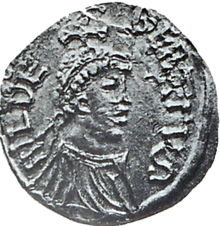 |
c. 496 Reims Son of Clovis I and Clotilde |
Ultragotha 510s 2 daughters |
13 December 558 Aged 61/62 Paris |
Son of Clovis I Inherited fiefdoms of Paris and Neustria |
| Chlothar I[1] The Old 13 December 558 – 29 November 561 |
 |
c. 497 Paris Son of Clovis I and Clotilde |
(1) Guntheuc 524 Childless (2) Radegund |
29 November 561 Aged 63/64 Compiègne |
Son of Clovis I Natural brother of Childebert I |
| Charibert I[1] 29 November 561 – December 567 |
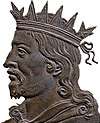 |
c. 517 Paris Son of Chlothar I and Ingund |
Ingoberga 537 4 children |
December 567 Aged 49/50 Paris |
Son of Chlothar I Half-brother of Chilperic I |
| Chilperic I[1] December 567 – September 584 |
 |
c. 539 Paris Son of Chlothar I and Aregund |
(1) Audovera 540s 5 children (2) Galswintha |
September 584 Aged 44/45 Chelles |
Son of Chlothar I Half-brother of Charibert I |
| Chlothar II[1] The Young September 584 – 18 October 629 |
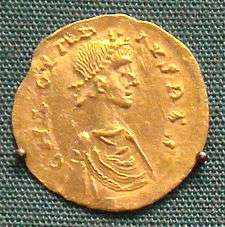 |
c. 584 Paris Son of Chilperic I and Fredegund |
(1) Haldetrude 1 son |
18 October 629 Aged 44/45 |
Son of Chilperic I |
| Dagobert I 18 October 629 – 19 January 639 |
 |
603[2] Paris Son of Chlothar II and Haldetrude |
(1) Gormatrude Childless (2) Nanthild |
19 January 639 Aged 33/34 Épinay-sur-Seine |
Son of Chilperic I Inherited all fiefdoms of Neustria |
| Clovis II 19 January 639 – 27 November 657 |
 |
633[3] Paris Son of Dagobert I and Nanthild |
Balthild 640s 3 sons |
27 November 657 Aged 23/24 |
Son of Dagobert I |
| Chlothar III 27 November 657 – Spring 673 |
652[4] Paris Son of Clovis II and Balthild |
Unmarried | Spring 673 Aged 20/21 |
First son of Clovis II | |
| Childeric II Spring 673 – Autumn 675 |
653[4] Paris Son of Clovis II and Balthild |
Bilichild ? 2 sons |
Winter 675 Aged 21/22 |
Second son of Clovis II | |
| Theuderic III Autumn 675 – 23 December 679 |
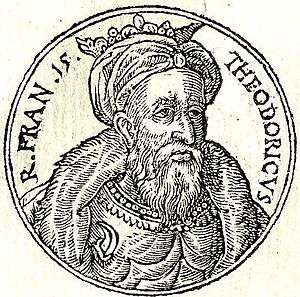 |
654 Paris Son of Clovis II and Balthild |
(1) Clotilda pre-675 2 sons (2) Amalberga of Maubeuge |
12 April 691 Aged 36/37 |
Third son of Clovis II |
Kings of the Austrasian Franks (511–679)
- King of both the Neustrian and Austrasian Franks
Merovingian dynasty
Chlothar II defeated Brunhilda and her grandson, reunifying the kingdom. However, in 623, to appease the local nobility and also secure the borders, he gave the Austrasians his young son as their own king. His son and successor, Dagobert I, emulated this move by appointing a sub-king for Aquitaine, with a seat at Toulouse, in 629 and Austrasia in 634.
| Name Reign |
Portrait | Birth | Marriage(s) Issue |
Death | Claim |
|---|---|---|---|---|---|
| Theuderic I[1][5] 27 November 511 – Early 534 |
.jpg) |
c. 487 Paris Son of Clovis I and an earlier wife: Evochildis of Cologne |
(1) Suavegotha 510s Childless (2) Several concubines |
Early 534 Aged 46/47 |
Son of Clovis I Inherited fiefdoms of Reims |
| Theudebert I[1] Early 534 – c. 548 |
.jpg) |
c. 503 Metz Son of Theuderic I and a concubine (prob.) |
(1) Deuteria 534 1 son (2) Wisigard |
c. 548 Aged 44/45 |
Son of Theuderic I |
| Theudebald[1] c. 548 – c. 555 |
c. 535 Son of Theudebert I and Deuteria |
Waldrada 540s Childless |
c. 555 Aged 19/20 |
Son of Theudebert I | |
| Chlothar I[1] The Old c. 555 – 29 November 561 |
 |
c. 497 Paris Son of Clovis I and Clotilde |
(1) Guntheuc 524 Childless (2) Radegund |
29 November 561 Aged 63/64 Compiègne |
Son of Clovis I Natural brother of Childebert I |
| Sigebert I[1] 29 November 561 – c. 575 |
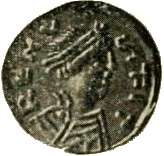 |
c. 535 Son of Chlothar I and Ingund |
Brunhilda of Austrasia 567 3 children |
c. 575 Aged 39/40 Vitry-en-Artois |
Son of Chlothar I Inherited fiefdoms of Metz and Reims |
| Childebert II c. 575 – March 595 |
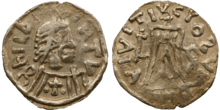 |
c. 570 Son of Sigebert I and Brunhilda of Austrasia |
Faileuba 4 children |
March 595 Aged 24/25 |
Son of Sigebert I |
| Theudebert II March 595 – 612 |
586 Son of Childebert II and Faileuba |
(1) Bilichilde 608 2 children (2) Teodechilde |
612 Aged 25/26 |
First son of Childebert II | |
| Theuderic II 612 – 613 |
.jpg) |
587 Soissons Son of Childebert II and Faileuba |
Several paramours 4 sons |
613 Aged 25/26 Metz |
Second son of Childebert II |
| Sigebert II 613 – Late 613 |
601 Son of Theuderic II and Ermenberge |
Unmarried | 613 Aged 11/12 |
Illegitimate son of Theuderic II | |
| Chlothar II[1] The Young September 584 – 623 |
 |
c. 584 Paris Son of Chilperic I and Fredegund |
(1) Haldetrude 1 son |
18 October 629 Aged 44/45 |
Son of Chilperic I |
| Dagobert I 623 – 634 |
 |
605 Paris Son of Chlothar II and Haldetrude |
(1) Gormatrude Childless (2) Nanthild |
19 January 639 Aged 34/35 Épinay-sur-Seine |
Son of Chilperic I Fiefdoms of Austrasia granted by local nobility |
| Sigebert III 634 – 1 February 656 |
630 Son of Dagobert I and Ragnertrude (concubine) |
Chimnechild of Burgundy 651 2 children |
1 February 656 Aged 25/26 |
Son of Dagobert I | |
| Childebert The Adopted 1 February 656 – 661 |
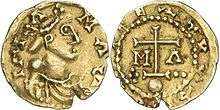 |
640s Son of Grimoald and Itta of Metz |
Unmarried | 661 Aged 20s |
Adoptive son of Sigebert III Chose as heir by his predecessor |
| Chlothar III 661 – Spring 673 |
649 Paris Son of Clovis II and Balthild |
Unmarried | Spring 673 Aged 23/24 |
First son of Clovis II | |
| Childeric II Spring 673 – Autumn 675 |
654 Paris Son of Clovis II and Balthild |
Bilichild 688 2 sons |
Winter 691 Aged 21/22 |
Second son of Clovis II | |
| Clovis III Autumn 675 – c. 676 |
c. 670 Son of Chlothar III and unknown paramour |
Unmarried | c. 676 Aged 5/6 |
Illegitimate son of Chlothar III | |
| Dagobert II c. 676 – 23 December 679 |
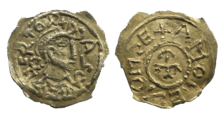 |
c. 650 Son of Sigebert III and Chimnechild of Burgundy |
Unknown woman 1 son (uncertain) |
23 December 679 Aged 28/29 Stenay |
Natural son of Sigebert III |
Kings of the Franks (679–840)
Merovingian dynasty
Theuderic III was recognized as king of all the Franks in 679. From then on, the kingdom of the Franks can be treated as a unit again for all but a very brief period of civil war. This is the period of the "idle kings" who were increasingly overshadowed by their mayors of the palace.
| Name Reign |
Portrait | Birth | Marriage(s) Issue |
Death | Claim |
|---|---|---|---|---|---|
| Theuderic III 23 December 679 – 12 April 691 |
 |
654 Paris Son of Clovis II and Balthild |
(1) Clotilda pre-675 2 sons (2) Amalberga of Maubeuge |
12 April 691 Aged 36/37 |
Third son of Clovis II |
| Clovis IV 12 April 691 – 695 |
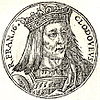 |
c. 677 Son of Theuderic III and Clotilda |
Unmarried | 695 Aged 17/18 |
First son of Theuderic III |
| Childebert III The Just 695 – 23 April 711 |
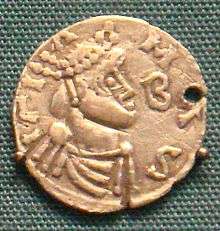 |
c. 678 Son of Theuderic III and Clotilda |
(1) Ermenchild 1 son (2) Unknown paramour |
23 April 711 Aged 32/33 |
Second son of Theuderic III |
| Dagobert III The Just 23 April 711 – 31 December 715 |
.jpg) |
c. 699 Son of Childebert III and Ermenchild |
(1) Unknown wife 1 son (2) Unknown paramour |
31 December 715 Aged 16 |
Second son of Childebert III |
| Chilperic II 31 December 715 – 13 February 721 |
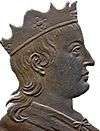 |
c. 672 Son of Childeric II and Bilichild |
Unknown concubine 1 son |
13 February 721 Aged 48/49 Attigny, Ardennes |
Second son of Childeric II First cousin of Dagobert III |
| Theuderic IV 13 February 721 – 16 March/30 April 737 |
 |
c. 712 Son of Dagobert III and unknown woman |
Unknown concubine 1 son |
16 March/30 April 737 Aged 24/25 |
Son of Dagobert III |
| Interregnum (737–741); Charles Martel reigned as Regent | |||||
| Childeric III The Phantom King 741 – November 751 |
 |
c. 717 Son of Chilperic II and unknown paramour |
Unknown paramour 1 son |
754 Aged 36/37 |
Illegitimate son of Chilperic II |
Carolingian dynasty
The Carolingians were initially mayors of the palace under the Merovingian kings, first in Austrasia and later in Neustria and Burgundy. In 687, Pippin of Heristal took the title Duke and Prince of the Franks (dux et princeps Francorum) after his conquest of Neustria in at the Battle of Tertry, which was cited by contemporary chroniclers as the beginning of Pippin's reign. Between 715 and 716, the descendants of Pippin disputed the succession.
In March 752,[6][7] Pippin (Pepin) became the King of the Franks and the office of mayor disappeared. The Carolingians displaced the Merovingians as the ruling dynasty.
| Name Reign |
Portrait | Birth | Marriage(s) Issue |
Death | Claim |
|---|---|---|---|---|---|
| Pepin The Short November 751 – 24 September 768 |
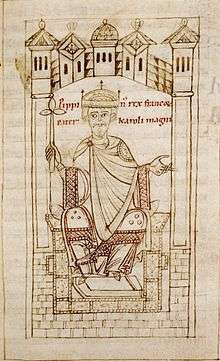 |
714 Son of Charles Martel and Rotrude of Trier |
Bertrada of Laon 741 5 children |
24 September 768 Aged 54 Saint-Denis |
Elected by Frankish nobles Coup d'état against Merovingians |
| Carloman I 24 September 768 – 4 December 771 |
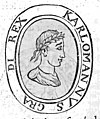 |
28 June 751 Soissons Son of Pepin the Short and Bertrada of Laon |
Gerberga 741 2 sons |
4 December 771 Aged 20 Samoussy |
Second son of Pepin the Short |
| Charles I The Great ("Charlemagne") 24 September 768 – 28 January 814 |
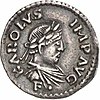 |
2 April 742 Son of Pepin the Short and Bertrada of Laon |
(1) Himiltrude (concubine) 768 1 son (2) Desiderata of the Lombards |
28 January 814 Aged 71 Aachen |
First son of Pepin III |
| Louis I The Pious 28 January 814 – 20 June 840 |
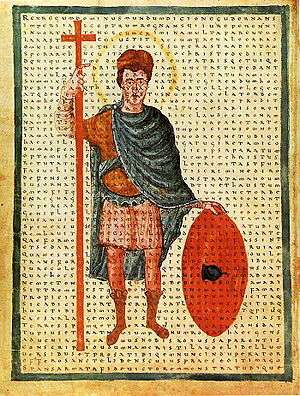 |
16 April 778 Casseuil Son of Charles I and Hildegard of the Vinzgau |
(1) Ermengarde of Hesbaye 794 6 children (2) Judith of Bavaria |
20 June 840 Aged 62 Ingelheim am Rhein |
Second son of Charles I |
Louis the Pious made many divisions of his empire during his lifetime. The final division, pronounced at Worms in 838, made Charles the Bald heir to the west, including Aquitaine, and Lothair heir to the east, including Italy and excluding Bavaria, which was left for Louis the German. However, following the emperor's death in 840, the empire was plunged into a civil war that lasted three years. The Frankish kingdom was then divided by the Treaty of Verdun in 843. Lothair was allowed to keep his imperial title and his kingdom of Italy, and granted the newly created Kingdom of Middle Francia, a corridor of land stretching from Italy to the North Sea, and including the Low Countries, the Rhineland (including Aachen), Burgundy, and Provence. Charles was confirmed in Aquitaine, where Pepin I's son Pepin II was opposing him, and granted West Francia (modern France), the lands west of Lothair's Kingdom. Louis the German was confirmed in Bavaria and granted East Francia (modern Germany), the lands east of Lothair's kingdom.
The following table does not provide a complete listing for some of the various regna of the empire, especially those who were subregna of the Western, Middle, or Eastern kingdom such as Italy, Provence, Neustria, and Aquitaine.
|
|
|
References
- William Deans; Frederick Martin (1882). A History Of France: From The Earliest Times To The Present Day. 1. Edinburgh & London: A. Fullarton & Co. pp. vi–ix, 420, 1792, Table Of Sovereigns Of France.
- Paul Oldfield, Sanctity and Pilgrimage in Medieval Southern Italy, 1000–1200, (Cambridge University Press, 2014), 218.
- McConville 2018, p. 362.
- Bachrach, Bachrach & Leese 2018.
- Contested by Munderic, 533, rival king in the Auvergne
- Charles Knight, The English Cyclopaedia: Volume IV, (London : 1867); p. 733 "We have no circumstantial account of this important event, except that Pepin was anointed at Soissons, in March 752, by Boniface, bishop of Mainz, called the Apostle of Germany, before the assembly of the nation."
- Claudio Rendina & Paul McCusker, The Popes: Histories and Secrets, (New York : 2002), p. 145
Further reading
- The history of France as recounted in the "Grandes Chroniques de France", and particularly in the personal copy produced for King Charles V between 1370 and 1380 that is the saga of the three great dynasties, the Merovingians, Carolingians, and the Capetians, that shaped the institutions and the frontiers of the realm. This document was produced and likely commissioned during the Hundred Years' War, a dynastic struggle between the rulers of France and England with rival claims to the French throne. It should therefore be read and considered carefully as a source, due to the inherent bias in the context of its origins.
- The Cambridge Illustrated History of France – Cambridge University Press
- The Origins of France: Clovis to the Capetians 500–1000 by Edward James ISBN 0-333-27052-5
- Late Merovingian France: History and Hagiography, 640–720 (Manchester Medieval Sources); Paul Fouracre (Editor), Richard A. Gerberding (Editor) ISBN 0-7190-4791-9
- Medieval France: An Encyclopedia, eds. W. Kibler and G. Zinn. New York: Garland Publishing, 1995.
External links
- "Merovingian dynasty". Encyclopædia Britannica Online. 2011.